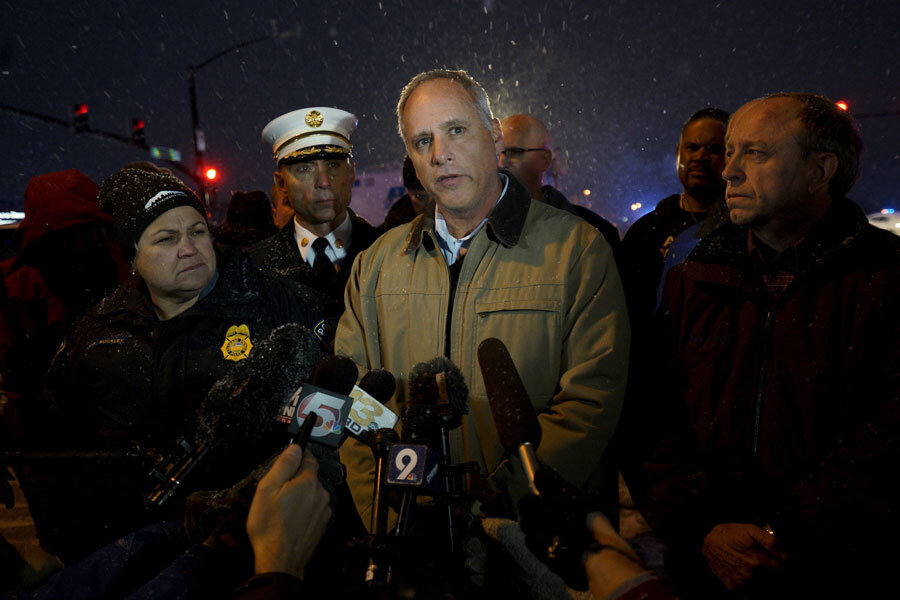Does anti-abortion violence influence pro-choice support?
Loading...
Support for legal abortion in the US is at a two-year high, according to new polls by both Gallup and the Associated Press.
A Gallup poll from earlier this year says 50 percent of Americans identify as pro-choice, above the 44 percent who identify as pro-life. And an AP-GfK survey conducted earlier this month says 58 percent of Americans now think abortion should be legal in most or all cases, which is up from 51 percent in January.
Neither Gallup nor AP suggest a direct correlation between anti-abortion violence and public opinion in their polls, but a survey of data from the last two decades raises the question: Can politically motivated violence galvanize public opinion?
The growing pro-choice support in the US comes the same year as the killing of three people at a Colorado Planned Parenthood clinic in November by an anti-abortion extremist.
“Some of the variation in public views on abortion over time coincides with political and cultural events that may have helped shape public opinion on the issue, including instances of anti-abortion violence….” Gallup suggests in their 2015 survey. But the Gallup survey was conducted in May, which suggests US public opinion was already shifting a pro-choice perspective before the November shootings occurred.
“In the decades-long history of violence against abortion providers, attacks have generally corresponded with moments when the temperature of the debate was hottest,” The Christian Science Monitor wrote last month after the Colorado shootings.
The debate was especially hot in the 1990s, when the divide between pro-choice and pro-life Americans was starkest and violence against abortion doctors and clinics simultaneously peaked.
“In the early 1990s, anti-abortion extremists concluded that murdering providers was the only way to stop abortion,” says the National Abortion Federation (NAF). NAF documents seven shootings by American anti-abortion extremists in the 1990s, resulting in eight deaths. And according to the May Gallup poll, the late 1990s witnessed the strongest pro-choice support in the US. In 1995, 56 percent of Americans identified as pro-choice compared to 33 percent of Americans who identified as pro-life.
Violence and a public opinion shifts also occurred simultaneously in 2009, when anti-abortion protestor James Poullion was shot and killed “while staging his usual protests involving large photos of mutilated fetuses,” The Christian Science Monitor reported. The same year, pro-choice support fell from 50 to 42 percent, while pro-life support rose from 44 to 51 percent. While the correlation between the data and killing suggests a relationship, it is unclear which one caused the other.
The national debate can inflame action by extreme supporters on both sides of the issue to act violently, but other cases of politically spurred violence suggest a reverse relationship also might exist: Violence may actually influence public opinion in the US.
The 1970 killing of four students protesting the Vietnam War at Kent State College challenged present US public opinion about the conflict and the nature of protests.
“Those directly exposed to the shootings had been radicalized as measured by – not being violent, but particularly increased political activity,” Dr. Jerry Lewis, professor emeritus of sociology at Kent State University who was present during the demonstrations, told NPR. “And that political activity, for the most part, was against the war.”
“And we further didn’t realize … how impactful the events of May fourth and 10 days later, [the shootings at] Jackson State were on the nation,” Dr. Lewis adds.
And more recently, the mass shooting at an Emanuel African Methodist Episcopal Church in Charleston, S.C., that killed nine in June restarted a latent national debate on the appropriateness of Confederate symbols in the south.
“The conflict over the banner of the Confederacy has been raging for decades between those who feel it is a symbol of free speech, and others who see it as a symbol of white supremacy,” wrote The New York Times in June. “But with a photo emerging of Dylann Roof, the 21-year-old suspect in the Charleston church shootings, posing in front of a car with Confederate plates, the debate has been reignited on social media and beyond about whether the flag should be displayed, and whether politicians should continue to defend the flag as a symbol of Southern heritage.”
After the Charleston shooting, Twitter was flooded with hashtags such as #takedownthatflag and #ConfederateTakeDown, and after Kent State shooting, over 4 million students public protested the Vietnam war. It is still unclear whether gun violence effectively shifts the temperature of the abortion debate, but history suggests it might be possible.








